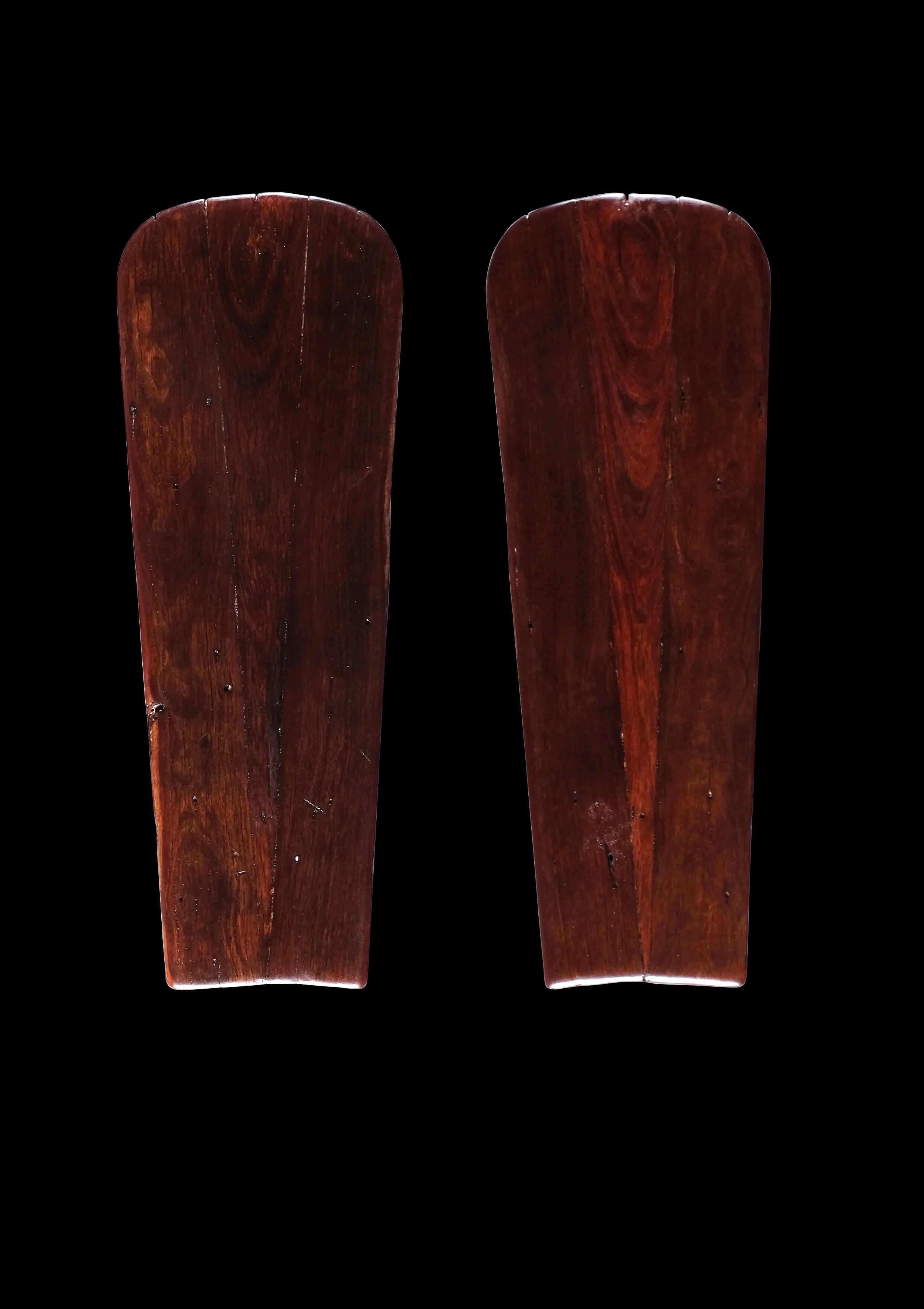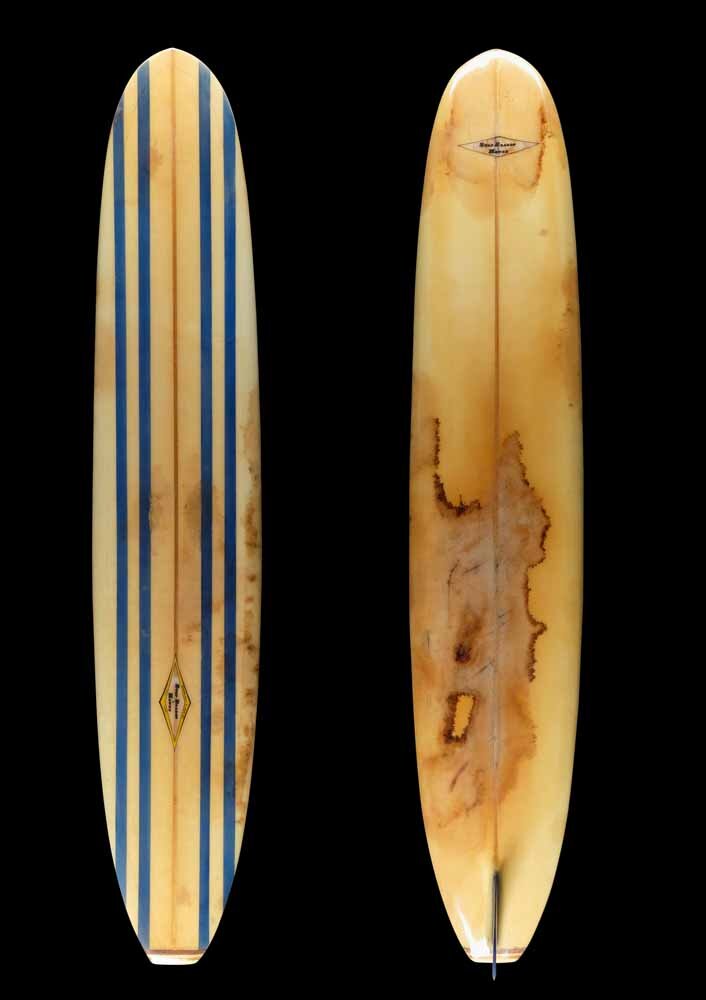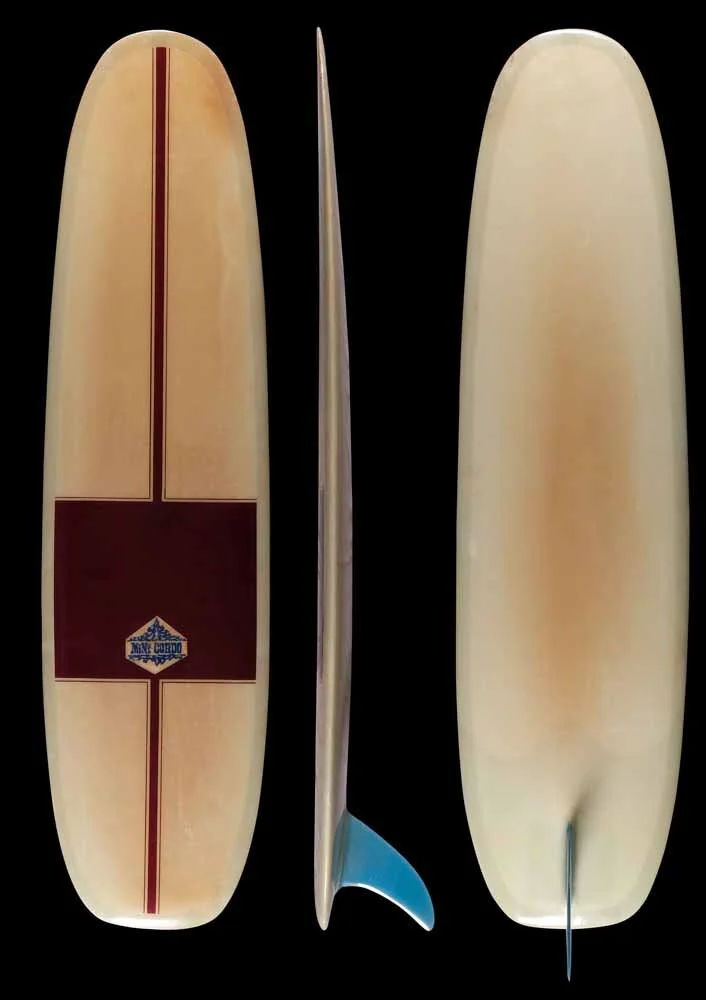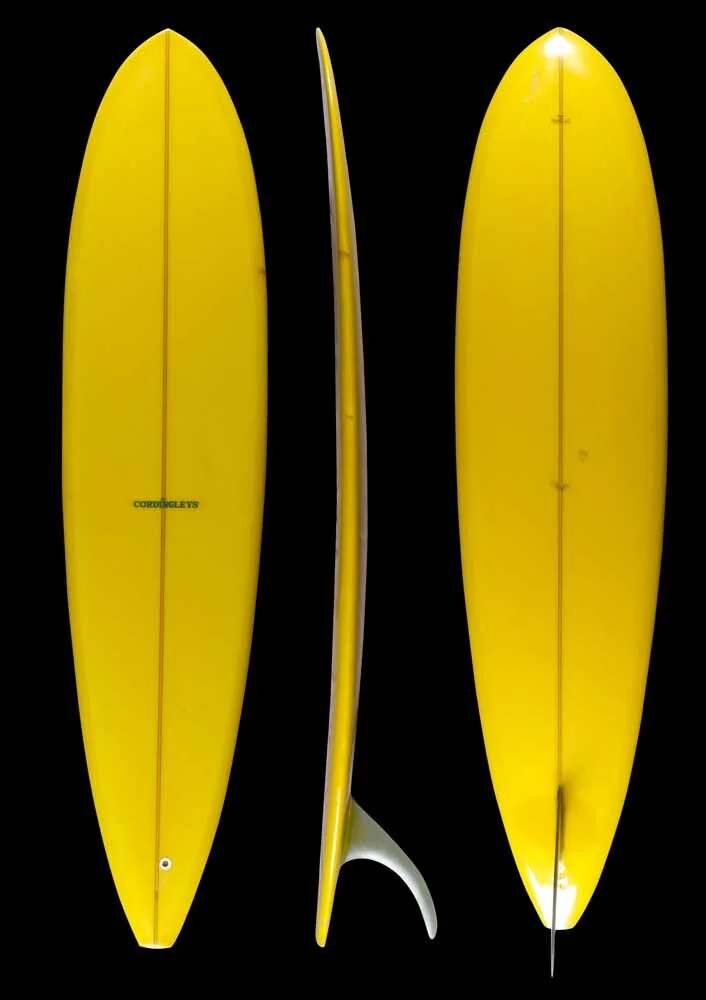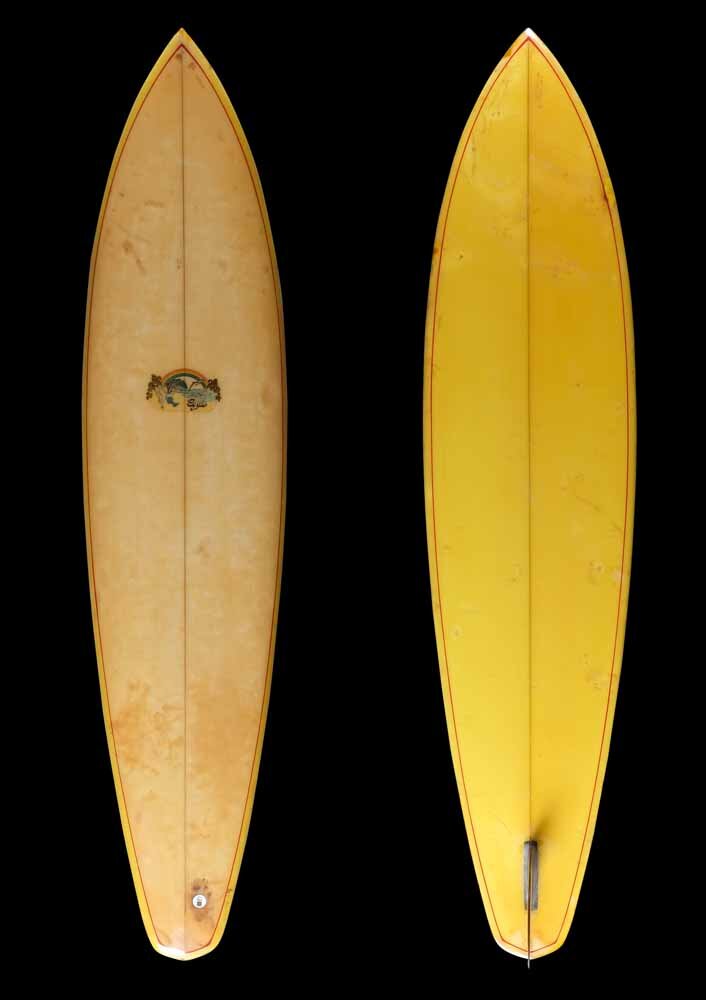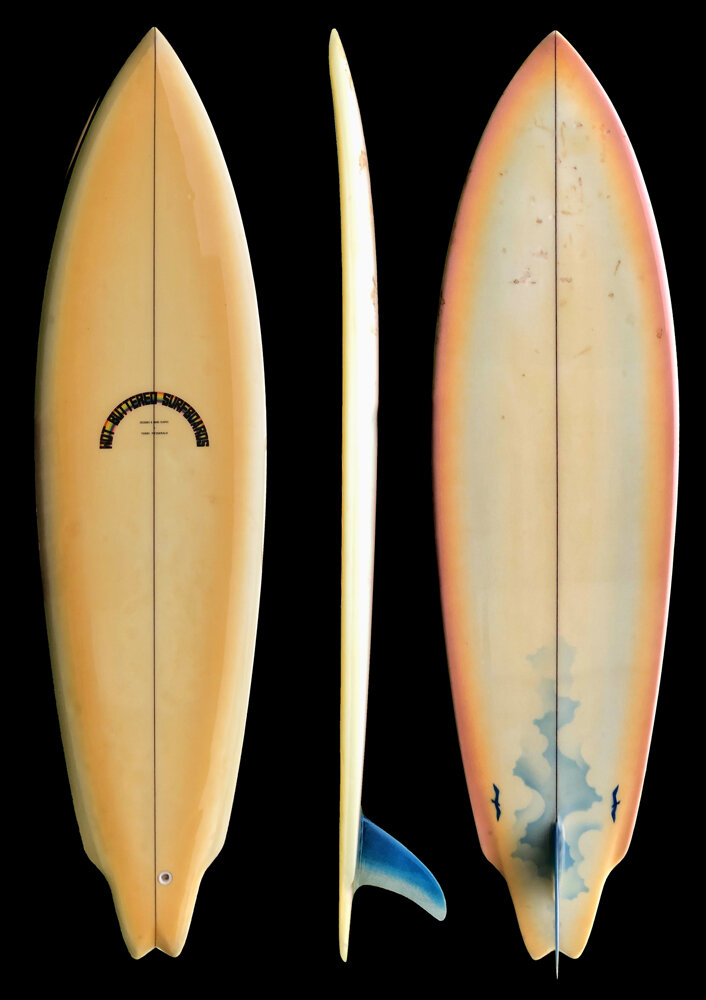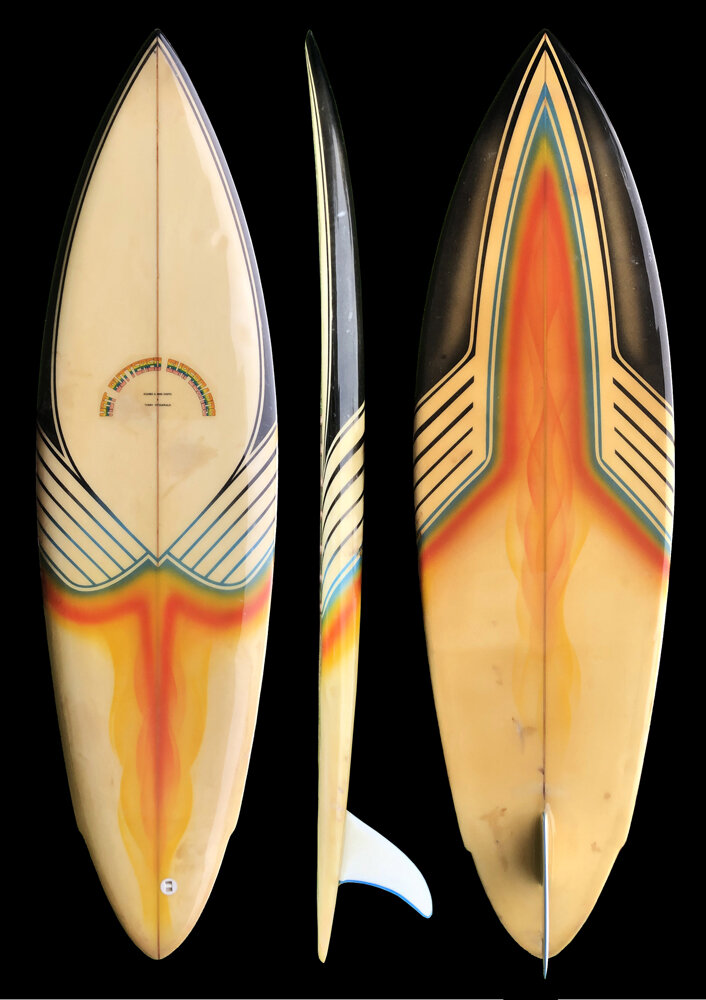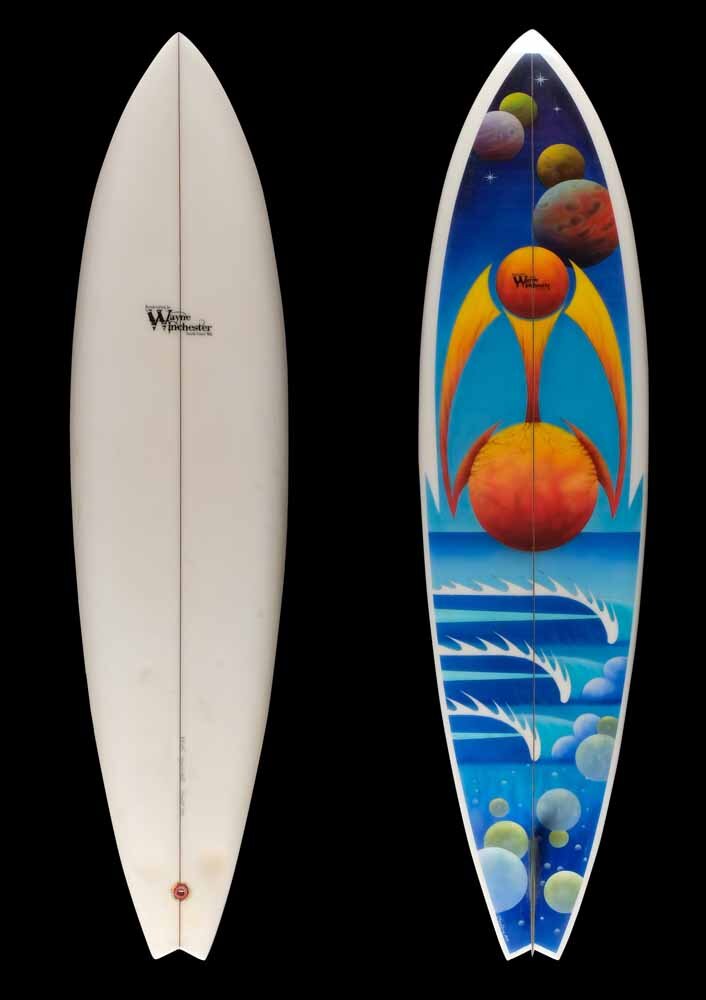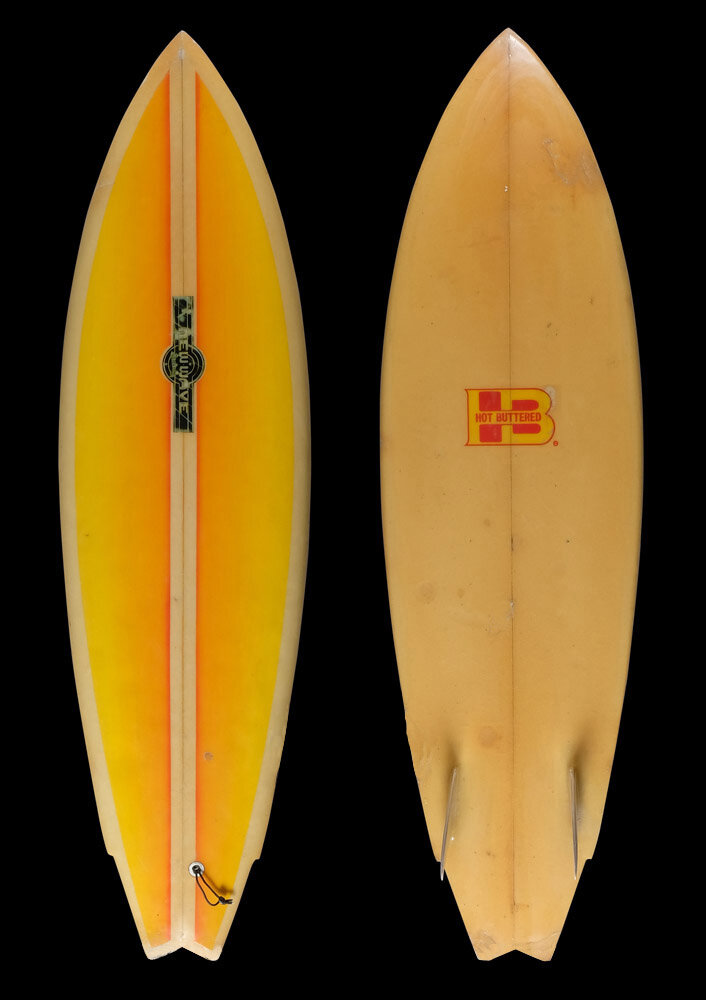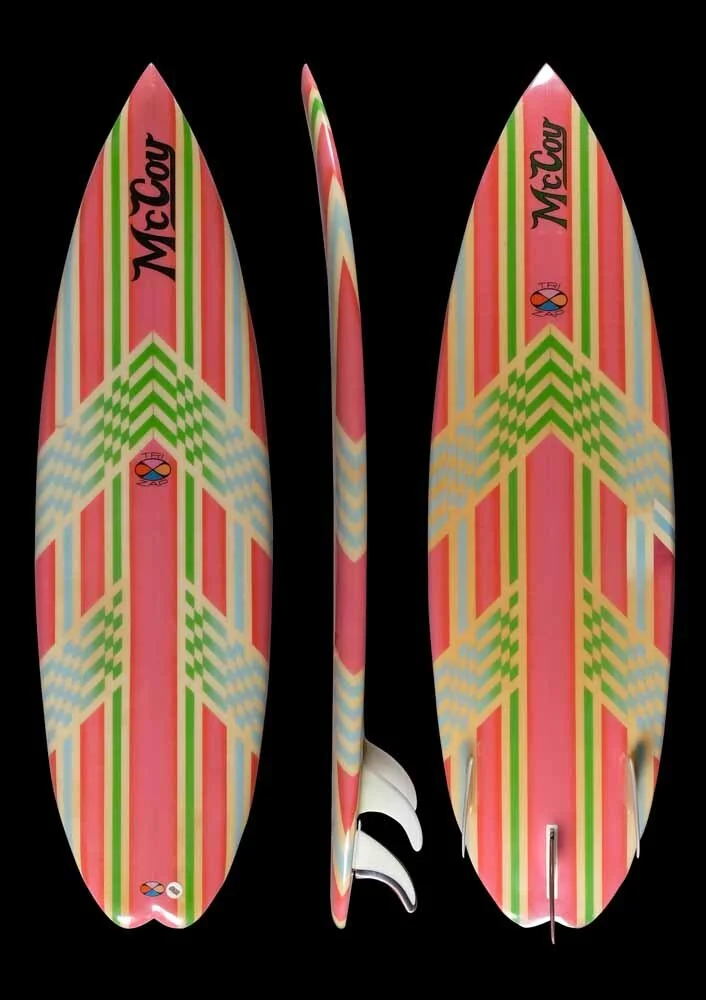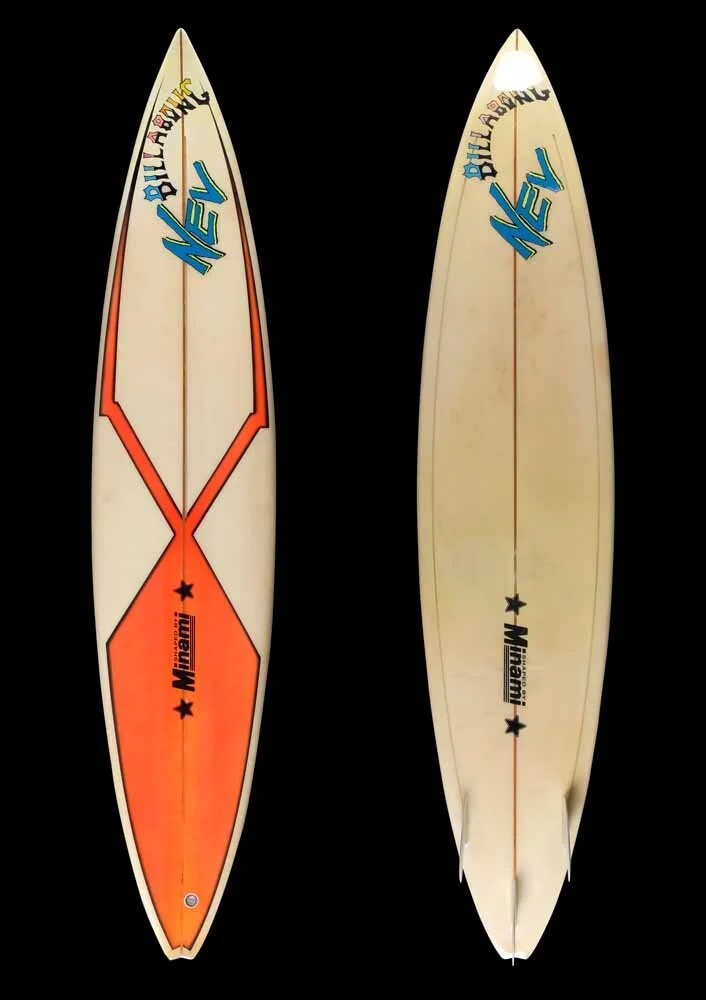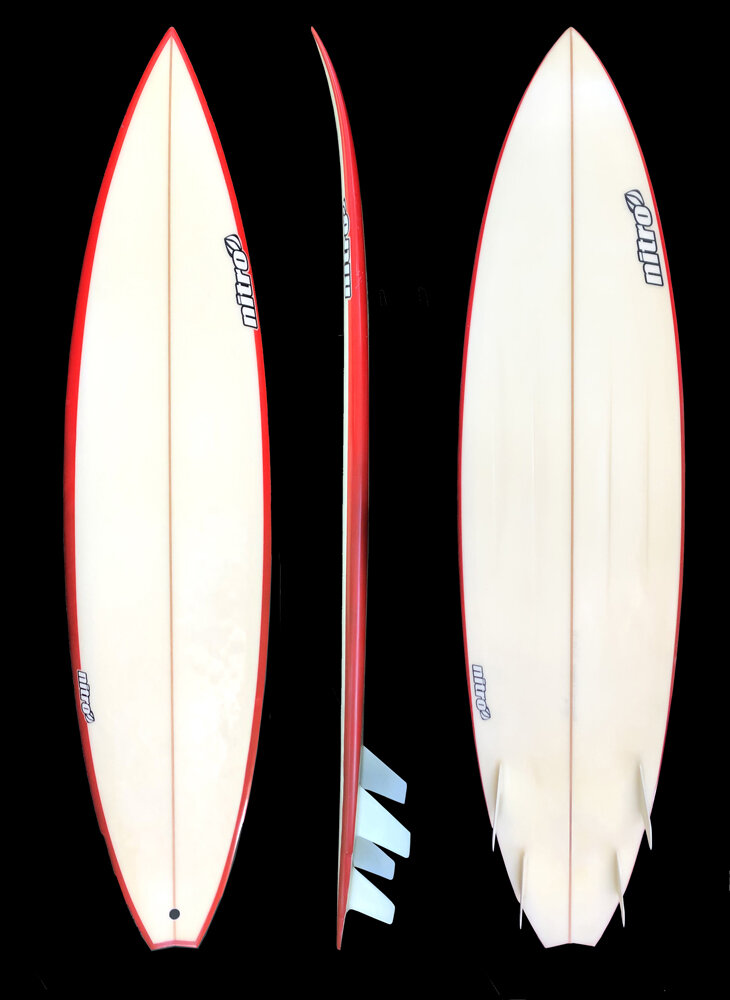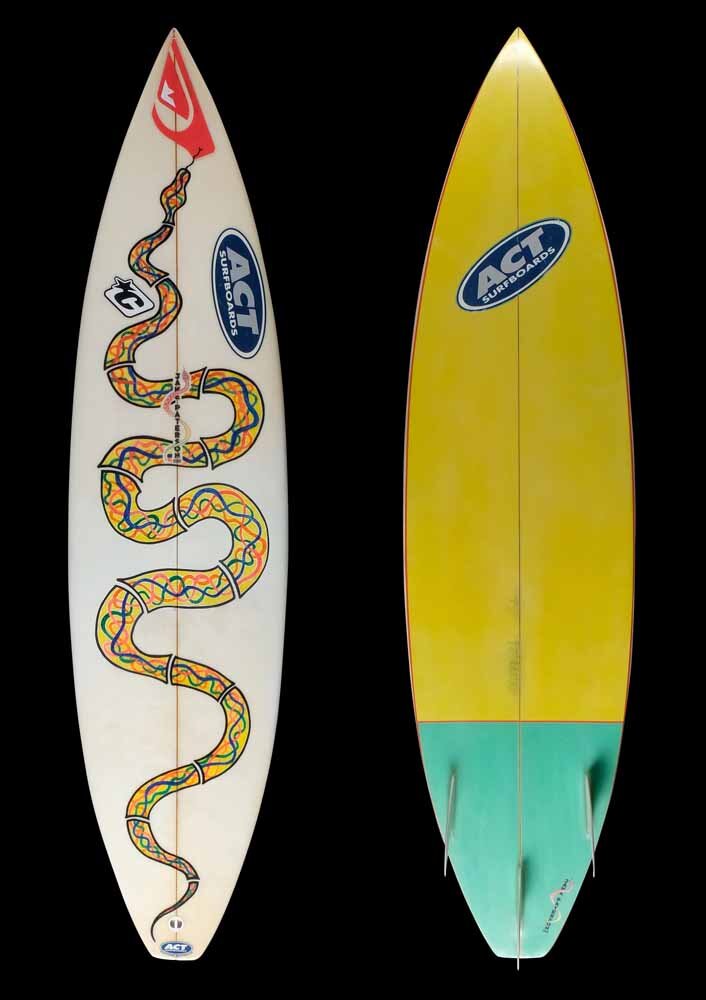vintage surfboardS
Collection
Wayne has been collecting boards for over 30 years and every board has its own story as to how he came across them.
"Sometimes the best gems come from the most unlikely of places, like the Michael Peterson that was picked up at an antique furniture auction. I was the only surfer in the room and the only bidder on the board… I couldn’t believe my luck.
As a long time manufacturer of new boards, customers often brought in their old clunkers as trade-ins. Although the value of these boards was not evident at the time… I’m so glad that I kept them in the back corner of the workshop. It’s amazing what 30 years can do to the value of a board.
For special boards, you sometimes just have to pay the bucks to get hold of a piece of history. My Lightning Bolt that was hand shaped by Gerry Lopez in 1974, is a special board that will only continue to increase in value and is not only a beautiful surfboard, but an investment for the future… not that I will likely ever sell it.
At the other extreme, some boards have come from the tip or roadside pick-ups… but I think these days are long gone as surfers realise the value and potential of old boards. The bargains are harder to come by and the hidden gems are usually uncovered by avid collectors very quickly. Don’t stop looking though… they are still out there."
Ancient Polynesia and Hawaii
The art of riding waves with a wooden board originated in Western Polynesia over three thousand years ago. During these ancient times, surfing was a deeply spiritual affair.
From the act of riding the wave, praying for good surf and rituals surrounding building a surfboard, surfing was a central part of ancient Polynesian culture.
In ancient Hawaii, surfing was also more than a mere recreational activity. The Hawaiian people integrated surfing into their culture and made surfing an art form. Their term for surfing translated into “wave-sliding”.
The ancient Hawaiian boards generally fell into 4 categories, defined by length and status.
· The paipo was made to be ridden in the prone position, like a body board.
· The alaia was made as either a standing or body board.
· The kiko’o was longer than the alaia and was used in bigger surf by experienced surfers.
· The olo was a very long surfboard that was reserved for royalty, reaching lengths up to 24’.
The timber boards displayed in this collection are replicas of Tahitian and Hawaiian surfboards from the 1800’s. They were made in 2012 by Wayne Winchester and have been created from 100 year old weathered hardwood, sourced from the south coast of Western Australia.
The birth of modern surfing
Board-riding received a strong revival in the early 1900’s when the “father of modern surfing”, Hawaiian Duke Kahanamoku, formed a surf club at Waikiki Beach, Hawaii.
The “Duke” subsequently brought the sport of surfing to Australia in 1915, where he demonstrated the ancient Hawaiian art of board riding at Freshwater in Sydney, New South Wales.
Until the 1920’s, Hawaiian surfboards were made of solid redwood timber and were usually around 16’ long and weighed up to 150 pounds (around 70 kg).
In 1935, after much experimentation, Tom Blake drilled hundreds of holes through a solid piece of redwood timber, allowed it to dry and then encased the board with plywood. A fixed fin was also attached, which gave it more stability and allowed for better control and manoeuvrability.
The weight of this board came down to around 100 pounds (around 45 kg) and revolutionised surfboard performance. These boards were much faster than the traditional solid timber ones and they soon became the industry standard and the world’s first mass-produced surfboard.
Hollow wooden boards remained popular in Australia through to the 1950’s. They gradually became shorter in length and eventually were made using a plywood exterior attached to internal timber ribs.
During the mid-1950’s, Californian surfers such as Joe Quigg and Dale Velzy were starting to make foam and fibreglass “malibu” boards. On a visit “down-under” in 1956, the Californians introduced this new type of construction to Australia.
Modern surfing had now truly arrived to our shores and the Australian surfing scene exploded.
The rebellious 60’s
Surfing became a rebellious cult in the 1960’s as the divide between surf lifesaving and a new generation of surfers tore apart years of beach tradition and culture.
A surfing revolution was about to unfold as surfers gained a reputation as society outlaws and drop-outs, causing havoc as they chased waves up and down the coast.
Surfboard construction of this era was primarily characterised by techniques using the newly developed foam and fibreglass materials.
The boards were relatively shorter and much lighter than the solid timber and hollow models. At the start of the decade, they were generally in the 9-10’ range. By the end of the decade, boards became incrementally shorter until they reached around 6’ in length.
These shorter boards were commonly called pocket rockets and were dramatically changing how waves were being ridden. Where the longer boards allowed surfers to move quickly along the face of the wave with some limited up and down movement, the shorter boards of the late 60’s now allowed surfers to also carve turns and manoeuvre in the steep “pocket” of the wave, close to the curl.
Fin shapes also changed dramatically throughout the decade. In the early 1960’s, the “D” fin was the standard shape, wide at the base with a vertical trailing edge. As the decade progressed, fins became longer, narrower at the base and more raked backwards.
With the introduction of shorter boards and streamlined fins, performance surfing was able to reach new levels.
The psychedelic 70’s
If the 1960’s bought cult status and new materials the 1970’s introduced a new era of radical design theory.
Experimental surfboards were the norm and many new models came and went. The early 70’s became known as the transition or psychedelic era… and nothing was off limits in surfboard design.
From the early to late 70’s, almost every conceivable surfboard design theory of the time had been tested, and mostly discarded. The “backyard board” was a common occurrence on beaches through-out Australia, as almost every surfer wanted to make and experiment with their own boards.
Surfboards also became lighter and more responsive to manoeuvres during this period, with stringerless boards and lightweight glassing adding to the experimental mix.
The introduction of leg ropes during the early 1970’s also meant that surfing performance could be pushed to the limits, without the fear of a long swim if you fell off. The first legrope was fashioned between 1971 and 1973 out of pliable, flexible surgical tubing. Legropes have since become a standard accessory on all modern surfboards.
The emergence of professional surfing commenced in 1975. There was now a need for performance surfboards that would allow surfers to pull off more and more radical manoeuvres in contest surfing.
The design revolution also extended to fin configuration and boards went from single fins to twin fins, before finally in 1980, Simon Anderson invented the 3 fin “thruster” surfboard.
Modern surfing was once again changed forever.
The rise of competition surfing in the 1980’s
The 3 fin “thruster” model surfboard was a proven performer and throughout the 1980’s, this configuration dominated surfboard design. Surfers could now perform radical manoeuvres knowing that the 3 fins would provide additional drive and hold in critical situations.
Surfboards of this period focussed on “fine-tuning” established design elements, as opposed to major redesign and experimentation. The boards became generally shorter and more performance focussed.
Custom made surfboards were a major part of 1980’s surfing culture. Surfboards were made to suit an individual surfer’s size, weight, surfing ability and locations surfed.
Many surfers had their own favourite shapers who worked closely with them to develop their surfing through incremental surfboard design changes. Surfboard shapers and manufacturers were well entrenched in almost all surfing towns around the Australian coast and it was a boom industry.
The professional competition circuit was also spreading across Australia and surfboards needed to keep up with high level performance requirements, where points were earned for manoeuvres.
Graphics and bright colours characterised the look of surfboards throughout the 1980’s and a new era of professional competition would soon see the surfboard become a canvas for sponsor’s logos.
Professional surfing of the 1990’s
Professional surfing, sponsorship and the emergence of major surfing companies such as Billabong, Quiksilver and Rip Curl became the hallmark of the 1990’s.
One surfer dominated the decade and provided the face of professional surfing across the globe. Kelly Slater was, and still is, one of the greatest surfers of all time. He has been crowned World Surfing Champion a record 11 times, including 5 consecutive titles from 1994 to 1998.
Surf travel was also now a regular occurrence as surfers had the means and desire to chase perfect waves across all parts of the world. Surfing was now truly global.
To meet increasing demand from a growing world-wide surfer population, the era of mass produced surfboards was about to arrive. Manufacturing became more streamlined, consistent and precise.
The 1990’s saw the development of computer software to design and manufacture surfboards. CAD/CAM surfboard programs hit the market in 1994 and continue to be a driver of surfboard design to the current day. The software can be linked to high tech machinery which automates the surfboard shaping process, producing high volume, finely tuned and consistent shapes.
As lightweight performance boards became the norm, they were snapping in half at an alarming rate. New manufacturing technologies were required to address the performance to strength ratio.
Experimentation commenced with lightweight Styrofoam cores and foam sandwich technology. This construction technique was creating superlight composite epoxy surfboards that would herald a new generation of performance surfing.
The techno 2000’s
By 2000, new technologies were seen as the future of surfing.
At the forefront of the new surfboard technology was a company called Salomon Industries, who ventured from snowboard into surfboard construction. They developed a hollow surfboard made from extremely lightweight high density foam, carbon fibre and epoxy resins. The boards had internal foam ribs, similar to the wooden ribs of the hollow boards from the 1950’s.
Surfers were also chasing larger and more powerful waves in all corners of the globe and were now able to track storms and giant waves with sophisticated computer modelling software.
Specially designed surfboards, along with jet skis, buoyancy vests and underwater breathing gear now allowed the bravest of surfers to launch themselves into unimaginably powerful waves.
Manufacturing was also heading offshore to Taiwanese and Chinese factories. Thousands upon thousands of surfboards were being pumped out of these factories and delivered to an insatiable world market. Sadly, many of the factory workers had never even seen the ocean, let alone understood the essence of surfing.
Mass production to a global market was about to decimate local surfboard industries. The competition from cheap imported surfboards sadly forced many local manufacturers out of business, as some of our finest and most respected craftsmen simply walked away from the industry.
The surfboard was rapidly becoming a commodity and the soul of surfing seemed destined to end.
The era of awakening and the resurgence of soul
Since the 2010’s we have seen a revival in the art of surfing and the bohemian surfer lifestyle.
The magic of a handcrafted surfboard is once again connecting with the mind and soul of surfers in Australia and across the globe.
Niche manufacturers have survived to shape and glass boards for an ever-increasing band of loyal followers in their local towns and beaches. These dedicated craftsmen are putting the soul back into surfboards.
In recent years there has been a resurgence of the retro boards of the 1960’s, 70’s and 80’s. New manufacturing techniques and modern design theory has breathed new life into the old surfboard models.
Today’s beaches now provide a kaleidoscope of surfboard shapes, designs and artwork.
We have once again discovered the simple joy of surfing… and the magical beauty of the surfboard.

